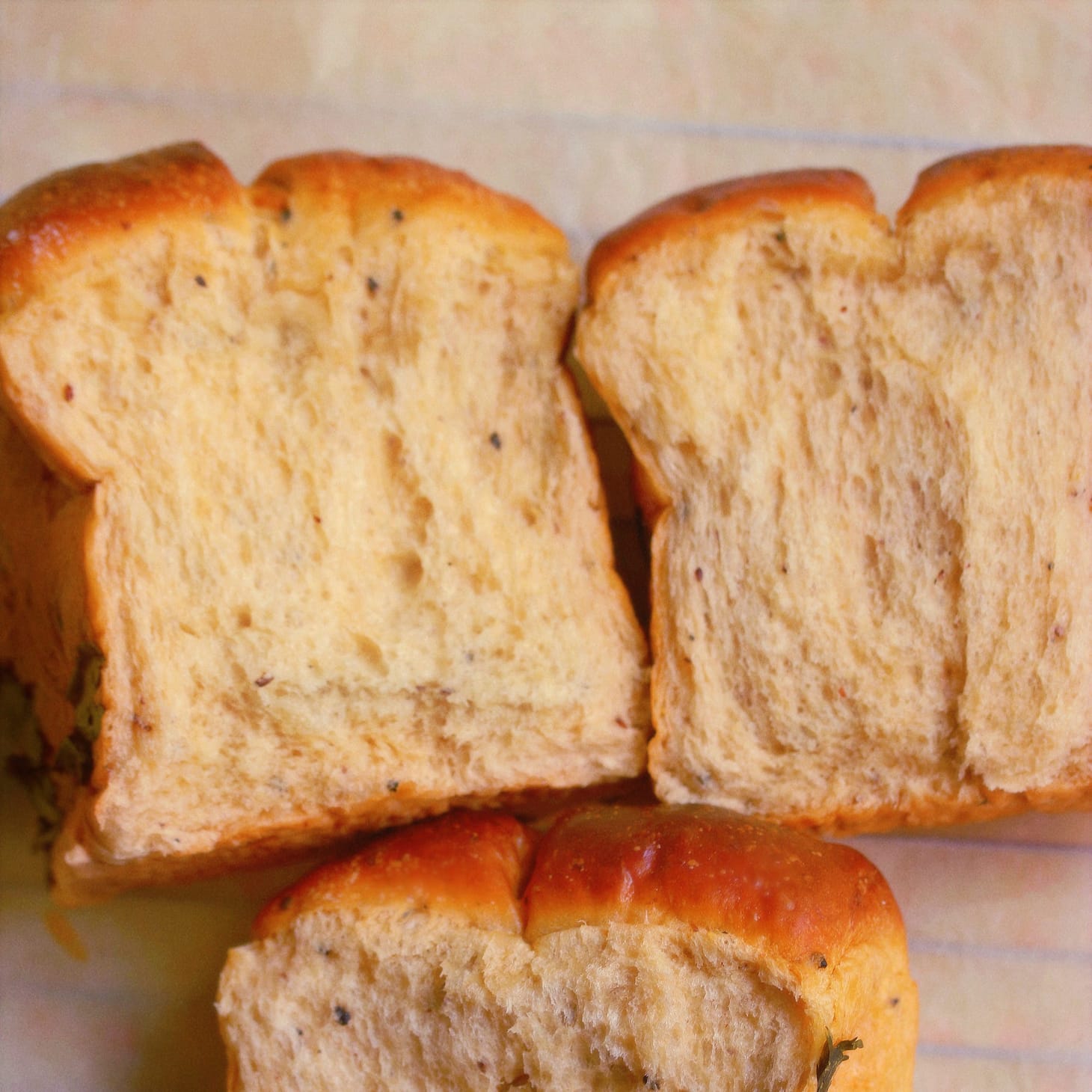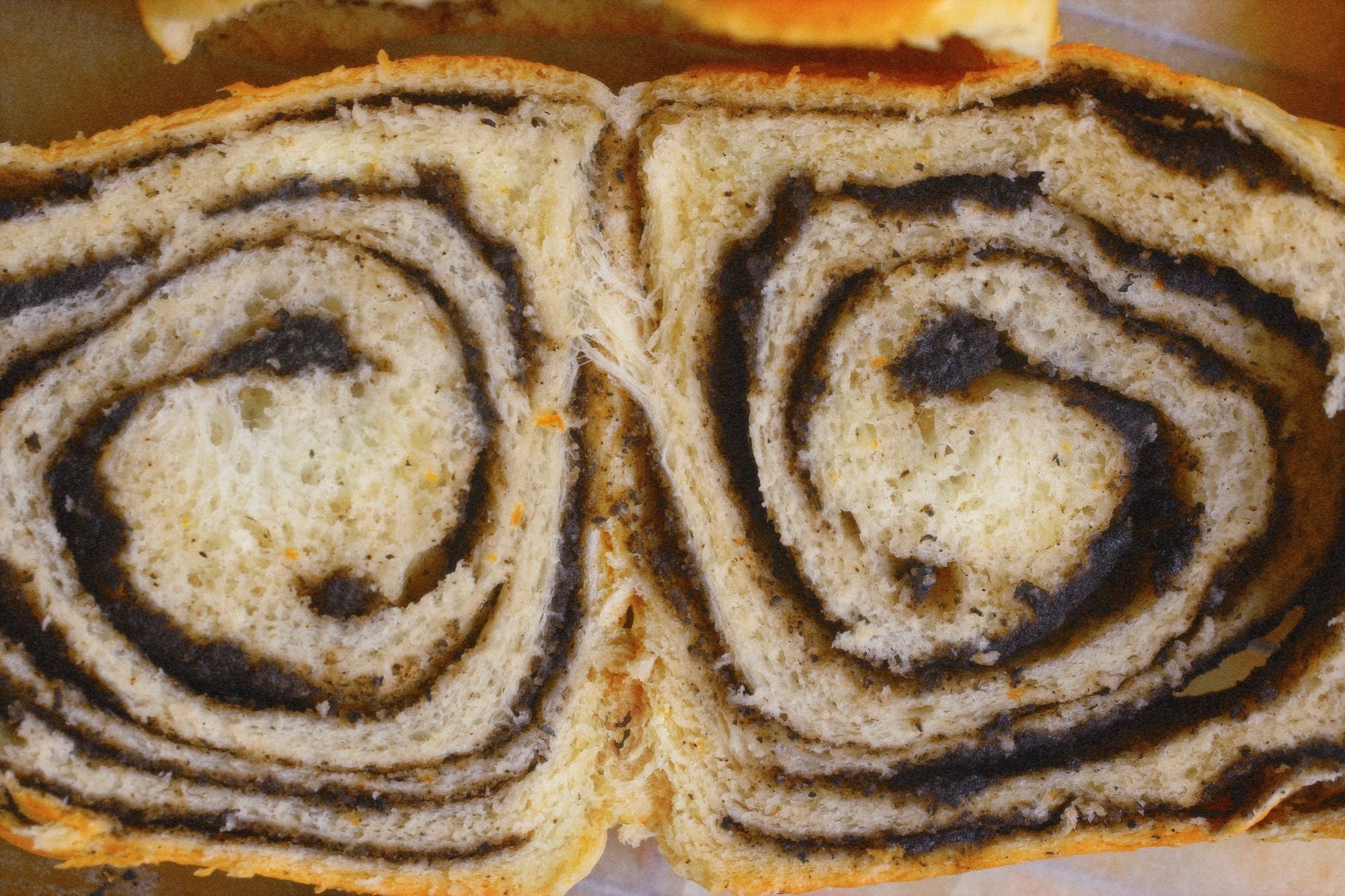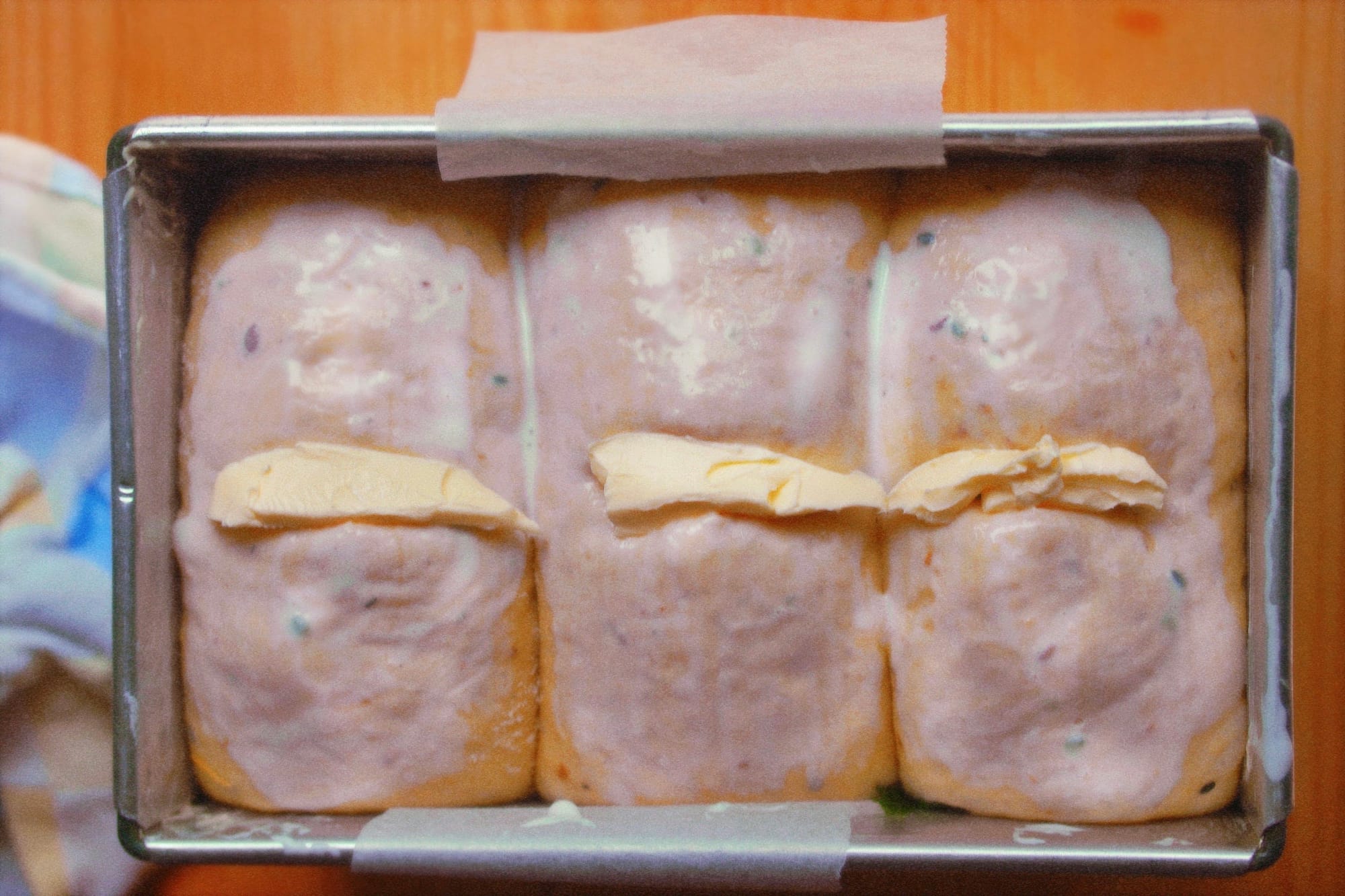In pursuit of vegan 'milk bread'
From guest poster Gan Chin Lin

Table of Contents
Today’s emails resume my plan to have a guest contributor to Wordloaf on a monthly basis. March brings us a pair of mega-posts from Gan Chin Lin, aka @tumblinbumblincrumblincookie, on the subject of Asian breads. Lin is one of my favorite poet-bakers/baker-poets, and today she’s covering one of my favorite subjects: the plush, squishy, cloud-breads of Asian baking. This post covers the background; the second (which will be in your inboxes soon), details the ins-and-outs of making great enriched breads with all-vegan ingredients, and it includes one of Lin’s recipes (which I tested and loved, of course.)
—Andrew

There is the tangzhong, a gently wobbling pudding of gelled starch. There is the yudane, scalded into a compliant earlobe-tender putty. But amongst these ‘dough improvers’—a loose term I use to describe the multifarious pastes with which Asian bakers try to extend the longevity, mouthfeel, taste and appearance of enriched bread—my favourite is the sweet stiff starter. It’s a kind of preliminary dough, a craggy high-sugar mass risen into a porous sponge full of long chambrous gluten structure (what the bakers call ‘honeycomb stage’): you might have seen this in panettone and stollen recipes. The leavening is done through natural yeast, instant yeast, or even sourdough starter.
In standard Mandarin, we call the sweet stiff starter 中种 (zhōng zhǒng—a two-step name only tonally differentiated, like the sing-song twin chimes of a doorbell). It holds a particular inflection of associative fondness/closely kinned intimacy to me, as the terms for family are structured similarly (lǎo lao, jiě jie, dì di, bà ba, mā mā). Something relationally vascular, kindred to your hands as they work and the rhythm of your practice.
In pursuit of vegan Asian enriched bread I, too, am always 中种: in the midst of something kinetic and alive, still morphing, still growing. Simultaneously always recovering history and prior knowledge, whilst trying to discover a way forward, especially as environmentally conscious models of baking become the imperative (but exciting, communal, joyful!) way to face a climate-changed future. The long stroke in the middle of the bracket; a rupture, an adventure.
I love, also, how 中 could mean two things. The first is ‘middle’, or ‘within’—the literal notion of a dough within a dough. But it could also mean ‘mid’, in media res; the term overall akin to ‘ferment-in-progress’, a temporal splice within an established, continuous duration.
In pursuit of vegan Asian enriched bread I, too, am always 中种: in the midst of something kinetic and alive, still morphing, still growing. Simultaneously always recovering history and prior knowledge, whilst trying to discover a way forward, especially as environmentally conscious models of baking become the imperative (but exciting, communal, joyful!) way to face a climate-changed future. The long stroke in the middle of the bracket; a rupture, an adventure.

It is easy to establish several historically significant points, of course. In Japan: when bread first entered through Portuguese traders, to the rice riots in Summer 1918 that created a nation wide incorporation of bread as a staple, and then the rise of sweetened milk—enriched doughs post World War II and American influence. In Taiwan, imports of flour—making machinery and wheat under the US Foreign Assistance Act in the 1960. The first time Asians won at the Coupe du Monde de la Boulangerie and the Mondial du Pain. The advent of ‘Hokkaido milk bread’ as a search term. Names like Yvonne Chen, Wu Pao Chun.
But there is no one annal recording or straightforward genealogy of different methods popularised in the world of Asian enriched breads. ‘Asian’ is an incurious categorical broadstroke, especially when you look at the rich history and diverse spread of native breads—leavened or not—across the entire continent. But it is the closest term used to encapsulate the regional spread of these enriched, sweet, soft doughs—often white in nature—which are the staple in bakeries across East Asia and Southeast Asia (‘milk bread’ doesn’t quite cut it either, especially when there are just as many recipes that don’t use milk as those that do). They are the kind you can find in a Chinatown bakery, if you’re in a Western country. Breads pursuing an especial plushness, an especial richness—and this blissful experience had to last beyond the day of baking, too; bread which resists staling for days, holding hydration like an athlete doing a plank.
Bread to me is synonymous with softness. All my life, only plush, white crumb, barely freckled with wholemeal kernel if ever that; egg-waxed crust with the miasma of richness that remains fragrant on the whorls of your fingertips for ages afterwards. Neighbourhood bakeries selling a bun per dollar, filled with curls of pink ham or gula melaka coconut, pats of smooth bean paste, the turmeric rubble of curried potatoes; topped with a rain of sesame, a skating rink of processed cheese with a few flakes of bright green parsley, a dot of yellow custard. I never knew the helmeted scorch and lactic tang of an artisan boule until much later, beyond my childhood; the closest were puffy swords of baguette from local French bakery chain Delifrance, and even those were just bouncy air and flour similar to the local versions of French bread known as “pointy head bread” (尖頭麵包) that were—like banh mi—a softer adaptation of their ancestors to our tastes. This was an exciting life, a rich life: bread as breakfast, quick meal, interim snack, dessert and late-night supper.
Of course, not everyone associates Asian enriched bread with the same kind of excellence, expertise and emotion as I do. Last July, a journalist I admire and follow deleted their innocuous tweet about milk bread, after it spawned a thread of unsolicited, very vehement derision. “It’s not even bread. More like a sucky cake,” reads one tweet; another calls it “horrible spongey foam…weirdly sweet like dehydrated marshmallow.” A picture of an artisanal brown loaf was sent in response, saying “My grandmother ran a German bakery. This is what I think of when I think of “bread.” “Much healthier,” the comment below concurred.
But more importantly, those who sniff at shokupan are missing out on the radical joy of embracing bread as an expansive term: bread as free play, as people activating yeast with what they have, across varied times and varied ambient environments. Those who claim to know real bread then know about cultures—like natural yeast, gastronomical cultures, too, are living and reactive to both preceding heritage and our contemporary practice. I’m not going to ever decry the legacy of beautiful local grain, wild yeast, brots and boules. But just as you feed your people, serve your community, I want to feed mine. Some have heritage wheat, but we don’t. Our heritage is the story of how we came to know wheat in the first place, and the exciting dynamic after, of what we did with it.
The discountenance at sweetness and enriched softness is curious to me, rather than offensive. What is ‘real bread’; how infallible is one’s sense of ownership over this ontological bedrock such that, when something that threatens to unseam this strangely immovable reality, it is so immediately destabilising as to trigger such conservative reactions? Ruby Tandoh wrote in 2017 of the wellness and class factors behind the fundamental logic behind those “crying for a return to some mythic purity,” suspiciously similar to the wax and wane of white versus wholewheat. White as a symbol of luxury in the Victorian era, to the flogging horse of anticarb cryers; wholegrains rising from peasant staple to the specialised stuff of artisans. You’d think that, more often than not, it wasn’t about the bread at all.
But more importantly, those who sniff at shokupan are missing out on the radical joy of embracing bread as an expansive term: bread as free play, as people activating yeast with what they have, across varied times and varied ambient environments. Those who claim to know real bread then know about cultures—like natural yeast, gastronomical cultures, too, are living and reactive to both preceding heritage and our contemporary practice. I’m not going to ever decry the legacy of beautiful local grain, wild yeast, brots and boules. But just as you feed your people, serve your community, I want to feed mine. Some have heritage wheat, but we don’t. Our heritage is the story of how we came to know wheat in the first place, and the exciting dynamic after, of what we did with it.
I want to invite you to the unlimited world of Asian bread. Where ‘roti’ in Singapore, Malaysia and Indonesia refers to traditional stovecooked breads (roti prata, roti canai, roti puri) and newer soft breads alike (roti sobek, roti benggali, roti paung); both are used to soak up our curry, but different kinds. Where the Japanese term for bread ‘pan’ パン is derived from the Portuguese pão, and the Philippines’ ‘pan’ opens up a world of pandesal, pan de siosa, pan de monja far beyond its original meaning of ‘bread of the Spanish’—both countries arriving, through different routes, at the same sound and desires from their rumbling bellies. I want to show you what professionals and homebakers before me have done with what was local to them: mashing root vegetables, turning beans and pulses into pastes, using starches like tapioca and rice; turning the material of our lived experiences into the fillings and bodies of unspeakably delicious loaves and buns.

Like the housewives and hobby bakers who make these formulas go viral through blogs (not a shortform for Instagram or TikTok; the old Wordpress and Blogspot dot coms with view counts, message boards and lists of Blogging BFFs on the side), I learnt about ‘champion breads’ through hearsay, one baker inspired by another and curious enough to try.
Of the sweet stiff starter recipes, the most famous iteration is the ‘5 Thousand Dollar Starter Dough Bread’ (五千元的老式面包). The recipe makes use of a sponge dough that constitutes half of the main body, and is uniquely specific in that it requires a low-protein flour/cake flour alongside high-protein bread flour (a proportion of 7:3). It proves over 3 stages—first, the sponge dough ferments and reaches a stage of gluten development known as a ‘honeycomb’; then, the bulk ferment once it is incorporated into the main dough; lastly, the final proof. It operates on 80% hydration, which is not exceptionally high, but makes up for it in the particular moisture-locking properties of the sponge dough, and a relatively high amount of butter.
The story is one of mimetic transmission: a tale of stories told, became a legend to be told in itself. You can see across the endless remakes from blogger to blogger, the thrill and intrigue in squaring themselves up to try this elusive vaunted recipe worth five thousand dollars in their own home kitchens, the excitement with which pictures captured the snowy sinew of softly shredded, fragrant enriched dough—testament to its quality—when pulling it apart. The accounts of those who were fed as a result.
The recipe first gained traction from blogger Victoria Bakes, who in turn got it from the blogger ‘Love and Liberty’ 爱和自由). You can see, from their post, that the initial aesthetic custom was to twist the dough in knots to show off the thready pull; now the sponge dough formula is used loosely in buns and loaves alike.
But what was most compelling about this bread recipe, when I first came across it, was the story it came with. According to the bloggers, a breadmaster called only known by his surname ‘Lee’ or ‘Li’ (李) spent five thousand RMB in his painstaking efforts to find this exact recipe, so deep was his desire to procure it (and hence, implicitly, how desirable and truly awesome the bread must have been). This recipe was then shared with another breadmaster, who then shared it with the blogger ‘Love and Liberty.’ Supposedly, the second breadmaster figured out the recipe through the specific characteristics divulged by 李: the ratio of flour to sugar; the use of custard powder; the mix of high protein and medium protein flour.
The story is one of mimetic transmission: a tale of stories told, became a legend to be told in itself. You can see across the endless remakes from blogger to blogger, the thrill and intrigue in squaring themselves up to try this elusive vaunted recipe worth five thousand dollars in their own home kitchens, the excitement with which pictures captured the snowy sinew of softly shredded, fragrant enriched dough—testament to its quality—when pulling it apart. The accounts of those who were fed as a result.
Bread as phenomena, as a joint experience; as myth and legend; the passing down of heritage—both the messy colonial (as with anything with wheat) and the rebuilding after. This is how I learnt about bread, off hobby bakers exulting in trickle-down recipes from professional bakers, passing around the table to fill everyone’s plate. My grandmother never made any of her own; there were no family recipes to pass, unless you happen to own a family-run confectionary. Yet to begin from democratically, selflessly shared tales and triumphs—a testament that baking often produces unparalleled generosity—is pretty damn cool. And this happens today, even on Instagram: I think of @thru1lense’s gamut of recipes and Abby @sour.lotti’s highly popular ‘Cloud Toast’ and ‘Katzoomi’ formulas. When there is success and excitement, it is always sweeter when shared.
→ Part 2, “Plant-powered pan パン (vegan bread, briefly, and a recipe)”
wordloaf Newsletter
Join the newsletter to receive the latest updates in your inbox.



